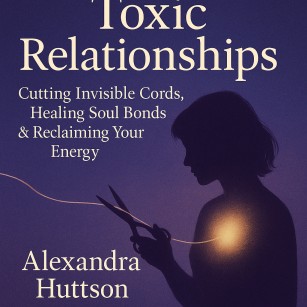Transformative Guide to Toxic Relationships
BOOKS REVIEW
Chaifry
7/25/20257 min read


Alexandra Huttson’s Toxic Relationships: Cutting Invisible Cords, Healing Soul Bonds & Reclaiming Your Energy emerges as a beacon for those ensnared in the subtle yet suffocating webs of unhealthy interpersonal dynamics. A spiritual healer and certified life coach, Huttson draws upon her extensive experience guiding clients through emotional turmoil to craft a guide that blends psychological insight, spiritual wisdom, and practical strategies. Published in 2024, this self-help book addresses the pervasive issue of toxic relationships, offering readers a pathway to recognize, sever, and heal from the invisible energetic cords that bind them to harmful connections. Set against a cultural backdrop where mental health awareness is burgeoning, the book resonates with a global audience seeking empowerment and emotional liberation.
This review posits that Toxic Relationships is an essential read for its compassionate approach, actionable tools, and profound exploration of self-worth, making it a vital resource for anyone striving to reclaim their emotional sovereignty. Its fusion of spiritual and psychological perspectives provides a holistic framework for healing, particularly relevant in an era where social media amplifies relational complexities. By outlining the book’s main points, critically analyzing its strengths and weaknesses with specific examples, and concluding with its broader significance, this review underscores why Indian youth, navigating intricate familial and social pressures, must engage with Huttson’s transformative work to foster resilience and authenticity.
Toxic Relationships is structured around three core pillars: identifying toxic dynamics, severing energetic cords, and reclaiming personal energy through healing. Huttson begins by defining toxic relationships as those that drain emotional, mental, or spiritual vitality, often through manipulation, gaslighting, or codependency: “A toxic relationship is a thief of your light, dimming your essence with every interaction” (Huttson, 2024, p. 5). She emphasizes their prevalence in romantic, familial, and platonic spheres, noting, “The most dangerous cords are those we cannot see, yet feel in our bones” (Huttson, 2024, p. 12).
The book’s first section guides readers to recognize toxicity. Huttson lists red flags such as chronic criticism and emotional exhaustion: “When you dread their presence more than you crave their love, you’re tethered to poison” (Huttson, 2024, p. 20). She introduces the concept of energetic cords, invisible ties formed through emotional investment: “Every heartfelt connection weaves a cord, but not all are woven with love” (Huttson, 2024, p. 28). Using case studies, she illustrates how these cords perpetuate cycles of pain, as in, “You give and give, hoping they’ll change, but the cord only tightens” (Huttson, 2024, p. 35).
The second section focuses on severing these cords through rituals and mindset shifts. Huttson advocates for visualization techniques, such as imagining cutting cords with a golden light: “See the cord dissolve, and feel your spirit lighten” (Huttson, 2024, p. 50). She stresses setting boundaries, asserting, “A boundary is not a wall; it’s a gate that honors your soul” (Huttson, 2024, p. 62). Practical exercises, like journaling prompts, help readers process emotions: “Write the words you never said, and let the paper hold your pain” (Huttson, 2024, p. 70). Huttson also addresses guilt, noting, “Guilt is the cord’s last grip; release it to reclaim your freedom” (Huttson, 2024, p. 85).
The final section explores healing and energy reclamation. Huttson emphasizes self-love as the foundation: “You cannot heal what you do not first cherish” (Huttson, 2024, p. 100). She offers meditations to restore energy, such as grounding exercises: “Feel the earth beneath you, anchoring your spirit in its embrace” (Huttson, 2024, p. 115). Forgiveness, both of self and others, is central: “Forgiveness is not absolution; it’s liberation from their shadow” (Huttson, 2024, p. 130). Huttson concludes with a vision of empowerment, encouraging readers to cultivate healthy relationships: “Surround yourself with those who amplify your light, not dim it” (Huttson, 2024, p. 150). The book ends on a hopeful note, affirming, “Your energy is yours to reclaim; step into your power” (Huttson, 2024, p. 180).
Toxic Relationships shines through its empathetic tone and accessible prose, making complex spiritual and psychological concepts digestible. Huttson’s ability to weave personal anecdotes with universal truths creates a relatable narrative, as seen in “A toxic relationship is a thief of your light, dimming your essence with every interaction” (Huttson, 2024, p. 5). Her use of metaphors, like cords and light, as in “The most dangerous cords are those we cannot see, yet feel in our bones” (Huttson, 2024, p. 12), renders abstract ideas tangible, enhancing reader engagement.
The book’s practical tools are a standout feature. Exercises like cord-cutting visualizations (“See the cord dissolve, and feel your spirit lighten”, Huttson, 2024, p. 50) and journaling (“Write the words you never said, and let the paper hold your pain”, Huttson, 2024, p. 70) empower readers to take immediate action. Huttson’s emphasis on boundaries, articulated in “A boundary is not a wall; it’s a gate that honors your soul” (Huttson, 2024, p. 62), is particularly impactful, offering a nuanced perspective that avoids vilifying others while prioritizing self-care. Her inclusion of case studies, such as a client escaping a narcissistic partner, grounds the advice in real-world applications, reinforcing the book’s credibility.
Huttson’s spiritual approach, blending mindfulness and energy work, broadens its appeal. Her meditations, like “Feel the earth beneath you, anchoring your spirit in its embrace” (Huttson, 2024, p. 115), provide solace for readers seeking deeper healing. The focus on self-love, as in “You cannot heal what you do not first cherish” (Huttson, 2024, p. 100), resonates universally, fostering a sense of agency. The book’s hopeful tone, culminating in “Your energy is yours to reclaim; step into your power” (Huttson, 2024, p. 180), inspires readers to envision a brighter future.
Despite its strengths, Toxic Relationships has limitations. Its heavy reliance on spiritual terminology, such as “energetic cords” (“Every heartfelt connection weaves a cord, but not all are woven with love”, Huttson, 2024, p. 28), may alienate readers skeptical of metaphysical concepts. While Huttson attempts to ground these ideas in psychology, the integration feels uneven, with phrases like “Guilt is the cord’s last grip; release it to reclaim your freedom” (Huttson, 2024, p. 85) occasionally sounding more poetic than substantive.
The book’s structure, while clear, can feel repetitive. The repeated emphasis on cord-cutting, as in “You give and give, hoping they’ll change, but the cord only tightens” (Huttson, 2024, p. 35), risks redundancy, particularly in the middle chapters. Some exercises, like repetitive journaling prompts, lack variety, which may disengage readers seeking diverse tools. Additionally, Huttson’s case studies, while illustrative, are brief and lack depth, making it hard to fully connect with the individuals’ journeys.
The book’s discussion of forgiveness, as in “Forgiveness is not absolution; it’s liberation from their shadow” (Huttson, 2024, p. 130), is insightful but underexplored. Huttson does not fully address the complexity of forgiving severe abuse, which may feel dismissive to readers with deep trauma. Finally, the text occasionally leans into generalizations, such as “Surround yourself with those who amplify your light, not dim it” (Huttson, 2024, p. 150), which, while uplifting, oversimplifies the challenge of navigating complex social networks.
Why Indian Youth Readers Must Read This Book
For Indian youth, Toxic Relationships is a vital read, resonating deeply with the cultural and social challenges they face in a rapidly modernizing society. The novel’s exploration of toxic dynamics, as articulated in “When you dread their presence more than you crave their love, you’re tethered to poison” (Huttson, 2024, p. 20), mirrors the pressures of navigating familial expectations, peer relationships, and romantic entanglements in India’s collectivist culture. Many young Indians grapple with obligations to family or societal norms that can foster codependency, making Huttson’s insight, “The most dangerous cords are those we cannot see, yet feel in our bones” (Huttson, 2024, p. 12), particularly relevant.
The book’s emphasis on boundaries, as in “A boundary is not a wall; it’s a gate that honors your soul” (Huttson, 2024, p. 62), is crucial for Indian youth, where asserting individuality often clashes with communal values. Huttson’s practical tools, like journaling (“Write the words you never said, and let the paper hold your pain”, Huttson, 2024, p. 70), offer a safe outlet for processing emotions in a culture where mental health discussions are still stigmatized. The concept of energetic cords, while spiritual, aligns with India’s rich traditions of yoga and mindfulness, making “Every heartfelt connection weaves a cord, but not all are woven with love” (Huttson, 2024, p. 28) accessible through a familiar lens.
Huttson’s focus on self-love, as in “You cannot heal what you do not first cherish” (Huttson, 2024, p. 100), empowers Indian youth to prioritize their well-being amidst societal pressures to conform. The book’s meditations, such as “Feel the earth beneath you, anchoring your spirit in its embrace” (Huttson, 2024, p. 115), resonate with India’s spiritual heritage, encouraging young readers to reconnect with their inner strength. The discussion of guilt, “Guilt is the cord’s last grip; release it to reclaim your freedom” (Huttson, 2024, p. 85), addresses the cultural tendency to prioritize duty over personal happiness, offering a path to liberation.
The book’s hopeful vision, as in “Surround yourself with those who amplify your light, not dim it” (Huttson, 2024, p. 150), inspires Indian youth to seek authentic connections in an era of social media-driven comparisons. Huttson’s call to forgiveness, “Forgiveness is not absolution; it’s liberation from their shadow” (Huttson, 2024, p. 130), is particularly poignant for young readers navigating familial conflicts or societal judgment. The empowerment articulated in “Your energy is yours to reclaim; step into your power” (Huttson, 2024, p. 180) encourages Indian youth to embrace their agency, a critical step in balancing tradition with modernity.
In a society where toxic relationships—whether with overbearing parents, manipulative peers, or controlling partners—are often normalized, Huttson’s insights, like “You give and give, hoping they’ll change, but the cord only tightens” (Huttson, 2024, p. 35), provide clarity and courage. Toxic Relationships is an essential read for Indian youth, offering a roadmap to emotional resilience, self-discovery, and the creation of healthy, empowering connections in a complex world.
Toxic Relationships: Cutting Invisible Cords, Healing Soul Bonds & Reclaiming Your Energy is a compelling guide that illuminates the path to emotional freedom with empathy and wisdom. Its vivid metaphors, as in “A toxic relationship is a thief of your light, dimming your essence with every interaction” (Huttson, 2024, p. 5), and practical tools, like “See the cord dissolve, and feel your spirit lighten” (Huttson, 2024, p. 50), make it a powerful resource for healing. Despite occasional repetition and an overreliance on spiritual language, Huttson’s work stands out for its accessibility and hopefulness, culminating in the empowering call to “Your energy is yours to reclaim; step into your power” (Huttson, 2024, p. 180). This book is highly recommended for readers seeking to break free from toxic dynamics and cultivate self-worth, offering a transformative journey toward emotional sovereignty.
